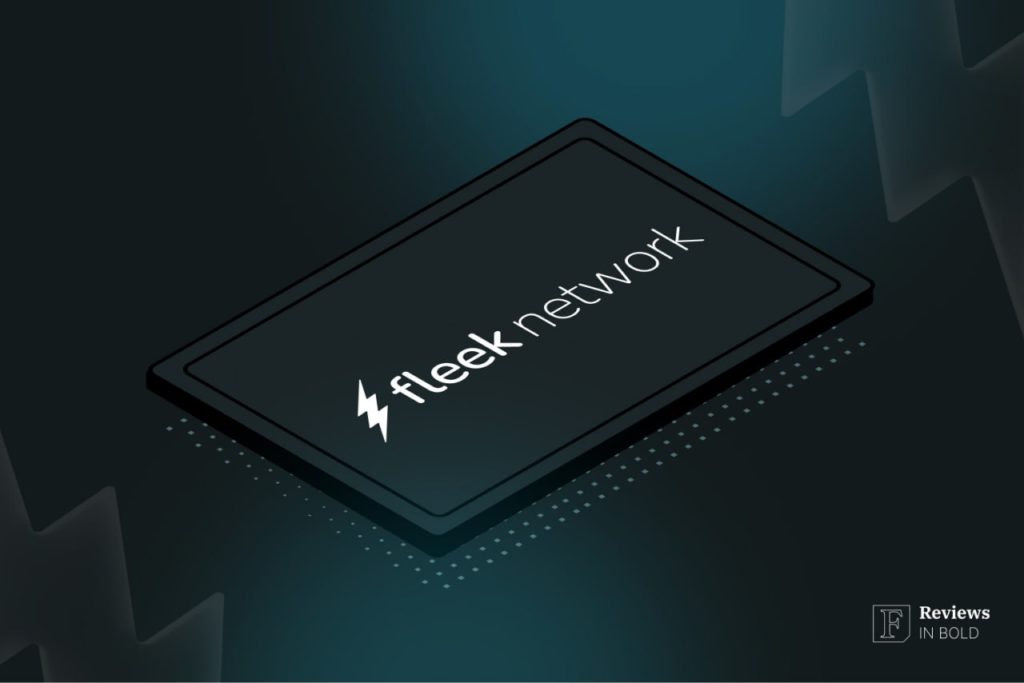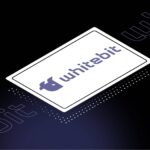This review looks at Fleek, a next-gen development platform for Web3 applications. Specifically, it considers what Fleek is, how it works, its ecosystem, and competitive advantages. Plus, there’s a section on a new kind of application class introduced by the platform called NFAs (non-fungible apps).
About Fleek Ecosystem

Since then, the platform has expanded its product line to include a CDN and Edge networking services platform (Fleek Network) and another for launching non-fungible apps (NFA).
- Fleek Network is a decentralized content and application layer designed to offer content delivery network (CDN) services. A CDN platform maintains a geographically distributed server network (or nodes) to bring web content or data distribution closer to the end consumer.

- The NFA project, on the other hand, entails a new concept of building Web3 apps. Ideally, now it is possible to launch Web3 dApps orchestrated through smart contracts for increased transparency, decentralization, and censorship resistance.

Nothing about creating and deploying a decentralized application (dApp) changes when launching an NFA, except now the metadata and other crucial information about the app are stored on-chain. NFAs are based on the same concept for creating and launching non-fungible tokens (NFTs).
Most dApp developers must utilize conventional infrastructure resources such as cloud computing service provers AWS (Amazon Web Services) and Cloudflare for storage and content distribution. Fleek is seeking to offer a decentralized solution to these legacy systems.
Developers can launch their dApps on censorship-resistant protocols utilizing IPFS (Inter-Planetary File System) file-sharing systems and the Fleek Network CDN. There are several advantages to taking the decentralized route, as we will discuss later in this review. Still, the main one is that dApps get access to performant, scalable infrastructure on demand.

How Does Fleek Work?
As mentioned before, Fleek offers a full-service infrastructure to Web3 dApp developers through two distinct platforms: Fleek.xyz and the Fleek Network. The former provides developers with the tools to create their dApps, while the latter offers the infrastructure for deploying these apps.
There are four components or building blocks within the Fleek.xyz platform that are instrumental for developers looking to create and launch their Web3 dApps. These are:
- Fleek UI (user interface)
- Fleek CLI (command line interface)
- Fleek SDK (software development kit)
- Fleek GraphQL API (application programming interface)

- The UI is a suite of tools used to create the interactive layer through which dApp users engage with the application. It is the front end of most apps, and it is what the user sees and uses to navigate around;
- Fleek CLI, or command-line interface, is a program on which a developer inputs text to initiate commands on the system level. In the Fleek case, the CLI enables developers to call modules within the Fleek Services layer;
- The software development kit (SDK) is another suite of development tools Web3 devs can use to integrate their apps with Fleek Services. It is a software library that saves on development costs and time by providing ready-made tools;
- The GraphQL API is a set of defined rules and standards that enable distinct applications to interact and share resources. Fleek, being a chain-agnostic protocol, enables different Web3 apps to interact through its interface, and this is possible through the API.
Fleek Services
The Fleek platform offers a number of services based on its decentralized architecture. They include the following:
- IPFS Hosting
- IPFS Storage
- ENS and IPNS (Domain Management)
- Dedicated IPFS Gateways & IPFS APIs
Let’s take a closer look at these services.
1. Fleek IPFS Hosting
The Interplanetary File System (IPFS) is a distributed file-storage protocol commonly used by blockchain-based networks such as Filecoin. With IPFS, a single file or database can be split into multiple files, which are then stored in various locations across the globe in a peer-to-peer network.
Whenever a file is requested by a user, it is served from these distributed nodes making this kind of file storage more secure and cost-effective for both users and network operators.
The Fleek Network CDN takes advantage of IPFS to offer edge computing services whereby it uses the closest nodes to the end user whenever it is serving data. IPFS hosting has become a great option for hosting Web3 dApps and websites.
2. Fleek IPFS Storage
Fleek makes it easy to upload files, store, pin, and fetch them at a user’s convenience quickly on the IPFS using the platform’s UI, CLI, and API modules. There are also other features, such as file resizing, compression, tagging, and archiving.
For security, Fleek enables redundant file archiving to ensure effective backups for all resources on the network.
As opposed to using file storage directly to IPFS protocols, users on Fleek can enjoy file retrieval speeds up to 10 times due to the innovative pinning feature.
3. Domain Management
Blockchain-based domain naming systems such as the popular ENS (Ethereum Name Service) and HNS (Handshake) are supported on IPFS, enabling users to link their hosting packages on Fleek with custom domains and manage it all under the same platform.
Currently, Fleek supports websites on IPFS and Internet Computer (IC) protocols.
4. Dedicated IPFS Gateways & IPFS APIs
Gateways are nodes that act as bridges between networks utilizing different protocols (rules of communication). For instance, we use gateways to link between home or workplace networks and a wide area network (WAN).
Fleek works with various networks as a chain-agnostic network and supports cross-chain communication with nodes across different protocols. The network maintains both IPFS and the Internet Computer gateways, the two most common decentralized file storage and networking protocols.
Fleek Protocol’s Competitive Advantage
Here’s what makes Fleek particularly useful, unique, and attractive to Web3 developers and other networking solution consumers, such as corporates and institutions.
- Decentralized (Censorship-resistant) – keeping up with the blockchain ethos of providing decentralized services, Fleek utilizes the unique IPFS networking system to ensure no single point of failure. Anyone can create a Web3 dApp, website, or business and host it on any of the partner IPFS platforms without getting any permits from regulatory authorities. This is unlike traditional content delivery networks;
- Scale with demand – as the blockchain grows in popularity, there is an expected increase in demand for file storage and performant platforms. Fleek has positioned its infrastructure in such as way as to scale as the demand for its services rises. By extension, any Web3 dApp hosted on Fleek can also scale as it attracts more users;
- Web3 content – Web3 is the next iteration of the world wide web (WWW) with applications that incorporate blockchain-based features such as token economics (tokenomics) and decentralization. Fleek supports the development and deployment of Web3 applications on the open web;
- Interoperable (chain agnostic) – Fleek is compatible with a host of other blockchain networks, including Ethereum (ETH), Polygon (MATIC), Cosmos (ATOM), Fuel, BNB Chain (BNB), Polkadot (DOT), Solana (SOL), and ImmutableX, among others. Integrations vary between applications and services, but all these are supported to some extent on the network. For instance, ENS domains can be used on websites hosted on Fleek;
- Peer-to-peer (P2P) – IPFS and the Internet Computer (IC) protocols make use of the decentralized nature of blockchain-based networks in which various nodes connect and communicate directly on the open web. This feature ensures that services such as websites and Web3 dApps launched on Fleek are resistant to censorship.
Recommended video: Watch Fleek CEO Harrison Hines explain the company’s vision, motivation, and how the network integrates into the larger blockchain vision of decentralizing products and services.
Fleek Protocol Pros & Cons

Pros
- Fleek is a trailblazer bringing, becoming the first blockchain protocol to enable decentralized CDN services;
- There is support for multiple blockchains;
- The network is performant, meaning that it is fast and scales with demand making it easily adaptable to the needs of Web3 dApps;
- It is censorship resistant;
- Innovative team pushing out blockchain-based solutions, including the recently released non-fungible apps (NFA) platform.

Cons
- Fleek is relatively young, even within the blockchain space, having been launched in 2019 as an Ethereum development studio;
- The network does not operate a native IPFS protocol but instead relies on third-party networks such as Filecoin and the Internet Computer.
Fleek Community Support Channels
- Fleek.co Website: https://fleek.co/
- Fleek.xyz Website: https://fleek.xyz/
- Fleek Network Website: https://fleek.network/
- Whitepaper: https://fleek.network/fleek-network.pdf?202303211908
- Twitter: https://twitter.com/FleekHQ
- YouTube: https://www.youtube.com/c/FleekHQ
- Facebook: https://www.facebook.com/fleekhq/
- GitHub: https://github.com/FleekHQ
- Blog: https://blog.fleek.xyz/
- Discord Forum: https://discord.gg/fleekxyz
Final thoughts
Fleek is introducing an innovative solution – a Web3 dApp development platform, a decentralized CDN, and an Edge networking solution. Not to forget the NFA product as well. These products and services demonstrate a new protocol that is looking to push the envelope in terms of innovation.
With the fast-paced nature of blockchain, its features, such as scalability on demand, chain agnostics, and cross-chain compatibility that, may prove a big attraction for developers going forward, and Fleek has a leg up in that sense.
However, it remains to be seen whether Fleek will maintain its first-mover advantage and lead the charge toward a more prevalent Web3 internet.
Risk Disclosure and Disclaimer
Frequently Asked Questions on Fleek
What is Fleek?
Fleek is currently a 2-in-1 blockchain protocol hosting a Web3 dApp development platform and decentralized CDN solution. Additionally, there is also a newly announced platform for non-fungible applications that will be part of the Fleek ecosystem.
What is the difference between Fleek.xyz and the Fleek Network?
Fleek.xyz is the Web3 dApp development platform that is scheduled to replace Fleek.co, while the Fleek Network is a content storage and distribution network, also called a CDN.
Is Fleek compatible with Ethereum?
Yes, some Fleek services are compatible with Ethereum, such as domain management which supports ENS (Ethereum Naming System) domains.
What are non-fungible apps (NFAs)?
NFAs are unique assets representing all the metadata that describes a Web3 dApp that are written to the blockchain the same way non-fungible tokens (NFTs) are encoded on-chain. It is a new feature by Fleek.




